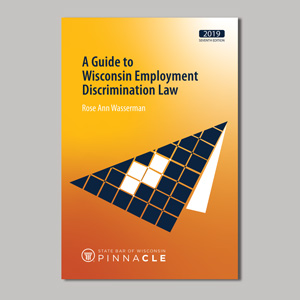
Justice Louis Brandeis once observed that “[p]ublicity is justly commended as a remedy for social and industrial diseases. Sunlight is said to be the best of disinfectants; electric light the most efficient policeman.”1 Workplace sexual harassment and other forms of sex discrimination exemplify this sentiment because powerful socioeconomic pressures have traditionally silenced many victims. That paradigm began to shift in 2017 in the wake of the Me-Too Movement. Emboldened by the recognition that others share their experiences, legions of women and men now feel less constrained to discuss their experiences publicly – and seek legal redress.
Today, all parties – and especially their counsel – must understand which causes of action, remedies, and defenses are available for sex discrimination claims. This article emphasizes those facets of two flagship statutes applicable to Wisconsin employers: the Wisconsin Fair Employment Act (WFEA) and Title VII of the Civil Rights Act of 1964 (Title VII). These laws have substantial similarities but differ in important ways.
Scope of Wisconsin Fair Employment Act
The WFEA prohibits employment discrimination based on 14 enumerated classes, including sex.2 Its legislative purpose is “to protect by law the rights of all individuals to obtain gainful employment and to enjoy privileges free from employment discrimination.”3 For these classes, the WFEA prohibits employers from discriminating in hiring, promotion, termination, and the “terms, conditions or privileges of employment.”4 The WFEA is a remedial statute, and courts interpret it broadly to protect qualified individuals.5 “[T]he WFEA is concerned with deterring and remedying intangible injuries which rob a person of dignity and self-esteem and with eliminating a discriminatory environment in the workplace that affects not only the victim of discrimination but the entire workforce and the public welfare.”6
The WFEA applies to employers, labor organizations, licensing agencies, and persons.7 The term employer is defined broadly to include “any … person engaging in any activity, enterprise or business employing at least one individual.”8 Thus, the WFEA applies to nearly every business in Wisconsin. This expansive definition also includes the state and its agencies.9 Although the statute does not define “other person,” the courts interpret it broadly.10 The WFEA also does not define “employee” except to exclude individuals employed by their parents and independent contractors.11
Sex Discrimination Under the WFEA
The WFEA prohibits sex discrimination in several forms: discrimination in pay or promotion, sexual harassment, gender-based harassment, sexual-orientation discrimination, childbirth discrimination, maternity leave and related medical conditions, and protection from retaliation.12 Further, the courts and the Labor and Industry Review Commission (LIRC), which reviews state agency decisions, have recognized claims for sexual-orientation harassment.13 Like Title VII, it protects women and men equally.14
 Storm B. Larson, U.W. 2018, practices with Bell Moore & Richter SC, Madison. He primarily practices in general liability defense, labor and employment law, and insurance law.
Storm B. Larson, U.W. 2018, practices with Bell Moore & Richter SC, Madison. He primarily practices in general liability defense, labor and employment law, and insurance law.
 Amy B.F. Tutwiler, U.W. 1994, is Dane County Corporation Counsel. Her work focuses primarily on employment and environmental law.
Amy B.F. Tutwiler, U.W. 1994, is Dane County Corporation Counsel. Her work focuses primarily on employment and environmental law.
The statute defines sexual harassment and identifies three forms. Sexual harassment includes unwelcome sexual conduct toward the employee including sexual advances, requests for sexual favors, and physical contact or other physical or verbal conduct of a sexual nature.15 This definition mirrors Title VII’s.16 To prevail on a sexual harassment claim, employees must establish that a reasonable person under the same circumstances would consider the conduct sufficiently “severe or pervasive to interfere substantially with the person’s work performance or to create an intimidating, hostile or offensive work environment.”17
In some situations, employers can lawfully discriminate based on sex. For example, the WFEA permits sex-based discrimination when “sex is a bona fide occupational qualification” (BFOQ). That standard requires that “all of the members of one sex are physically incapable of performing the essential duties required by a job” or that “the essence of the employer’s business operation would be undermined if employees were not hired exclusively from one sex.”18 Proving a BFOQ imposes a “very heavy” burden on the employer.19 A lack of BFOQ precedent within the last 15 years suggests that employers almost never rely on it now.
Scope of Title VII of the Civil Rights Act of 1964
Title VII prohibits discrimination on the basis of sex, race, color, religion, and national origin.20 The WFEA’s list (14) dwarfs Title VII’s list (5). The original draft of Title VII did not include “sex”; some people contend that it was added as a poison pill to defeat the legislation.21 Others, however, believe the intentions of the amendment’s author were genuine.22 Although sexual orientation is not listed in Title VII, the U.S. Court of Appeals for the Seventh Circuit, the U.S. Court of Appeals for the Second Circuit, and the EEOC have concluded that Title VII prohibits it as a form of sex discrimination.23
Title VII covers private employers, labor unions, state and local governments, federal agencies, and employment agencies.24 Whether Title VII will apply to an employer depends on the size of the employer.25
The U.S. Supreme Court interprets Title VII’s purpose broadly as an effort “‘to strike at the entire spectrum [of] disparate treatment of men and women in employment.”26 Employers cannot discriminate on the basis of those classes relative to an employee’s terms and conditions of employment, compensation, or privileges of employment.27 That includes hiring, firing, pay, benefits, transfer, and promotion. Title VII also prohibits employers from retaliating against employees for asserting their Title VII rights.28
Sex Discrimination Under Title VII
Title VII prohibits unequal treatment based on a person’s sex. The EEOC has recognized that Title VII prohibits pregnancy discrimination,29 pay or promotion discrimination, transgender discrimination,30 sexual harassment,31 and sexual-orientation discrimination.32 Title VII also protects individuals from retaliation.33
Federal regulations identify three forms of sexual harassment: 1) when unwelcome behavior is a term or condition of employment, 2) when such conduct is a basis for employment decisions, and 3) when such conduct creates a hostile work environment.34 For hostile work environment claims, the sexual harassment must be sufficiently severe or pervasive “to alter the conditions of employment and create an abusive working environment.”35 The conduct in question must be both objectively and subjectively offensive.36 Juries make that determination on a case-by-case basis.
Title VII does not mandate general workplace civility; therefore, not all inappropriate behavior is actionable.37 Notably, the standard only requires that behavior be severe or pervasive; a single incident can violate Title VII.38 The prohibition against sexual harassment does not specify the sex of individuals to whom it applies, so under Title VII both women and men are protected regardless of the harasser’s gender.
For hostile work environment claims, the sexual harassment must be sufficiently severe or pervasive “to alter the conditions of employment and create an abusive working environment.”
Title VII also contains a BFOQ defense.39 “[It] allows employers to intentionally discriminate based on gender by adopting … facially discriminatory employment practice[s] if reasonably necessary [for] the normal operation of the business.”40 Employers must show that all or substantially all members of one sex cannot perform the essential functions of the job.41 Because the BFOQ defense contradicts the purpose of Title VII, the U.S. Supreme Court has interpreted it narrowly.42
The Supreme Court explained the scope of the BFOQ defense in a seminal decision, Dothard v. Rawlinson.43 In that case, the Court described the BFOQ defense as “extremely narrow.”44 The Court upheld the requirement of a men’s prison in Alabama that guard applicants be men, not women.45 Sex was thus a BFOQ. The Court upheld this requirement, and agreed that allowing only men to be guards was necessary given the unusually dangerous atmosphere of a men’s penitentiary and the fact that inmates may be tempted to assault or otherwise disobey a woman guard.46 The Court was careful to ground its reasoning in expert testimonial evidence and to explain that the unique facts of the case commanded this outcome.47
Administrative Process: Title VII and WFEA
Most discrimination complaints are resolved at the administrative level, which is where individuals must first seek relief. To pursue claims under the WFEA and Title VII, the complainant must file a complaint with the Equal Rights Division (ERD) of the Wisconsin Department of Workforce Development or the federal Equal Employment Opportunity Commission (EEOC) within 300 days after the alleged discrimination.48 Hostile work environment claims are timely so long as any act of harassment that is a part of the same pattern of such behavior occurs within the 300-day period.49
Complaints filed with one agency are automatically cross-filed with the counterpart agency. The EEOC typically takes longer to reach a conclusion than the ERD because it receives more complaints. It frequently adopts the ERD’s findings.
The ERD and the EEOC have similar investigation processes. At the state level, the ERD assigns an investigator to review each party’s written submissions and investigate the issues. Investigative authority is broad and includes subpoena power and the authority to advise the complainant to amend the complaint if the respondent might have engaged in an incident or type of discrimination not specifically alleged.50 The investigator makes an initial determination regarding whether probable cause exists to believe discrimination has occurred.51
To pursue claims under the WFEA and Title VII, the complainant must file a complaint with the Equal Rights Division (ERD) of the Wisconsin Department of Workforce Development or the federal Equal Employment Opportunity Commission (EEOC) within 300 days after the alleged discrimination.
Complainants may appeal findings of no probable cause within 30 days after the date of the initial-determination finding.52 The complainant similarly has a right to a hearing on the merits for any issues on which the initial determination finds probable cause.53 Upon certification to hearing, the parties have a right to conduct discovery preceding both probable-cause and meritshearings.541 An administrative law judge (ALJ), referred to as an “examiner” by statute, conducts the hearings.55
The EEOC’s process is similar.56 However, unlike the ERD, the EEOC lacks adjudicative authority and cannot decide the claims at issue.57 It has 180 days to investigate claims; after that it must, upon request, issue the complainant a notice-of-right-to-sue letter, which authorizes the complainant to file the claim in federal court subject to a 90-day limitation period.58 The EEOC may also sue on an employee’s behalf.59
Learn More with Guide to Employment Discrimination
 Even when most employment is at will, anti-discrimination laws apply. Help ensure your clients get the right people for the job, the right way.
Even when most employment is at will, anti-discrimination laws apply. Help ensure your clients get the right people for the job, the right way.
This State Bar of Wisconsin PINNACLE® book provides an overview of fair employment laws. It then takes a deeper look at proof of discrimination, prohibited bases of discrimination, and other restrictions under the WFEA. Other chapters discuss procedures under the WFEA, as well as under federal and local fair employment laws, and the remedies available.
Guide to Employment Discrimination Law
444+ pp.; 7th ed. 2019-2020
$95/member; $125/nonmember
Available at https://marketplace.wisbar.org or phone (800) 728-7788
Remedies: WFEA and Title VII
Title VII authorizes compensatory and punitive damages.60 The WFEA does not. However, Wisconsin examiners have the power to issue orders that “will effectuate the purpose” of the WFEA.61 That statute authorizes awarding back pay accruing no more than two years before the filing of a complaint under the WFEA.62 The examiner also can award reinstatement, or in cases in which retaliation is proven, front pay in lieu of reinstatement.63 Front pay is statutorily restricted to “not less than 500 times nor more than 1,000 times the hourly wage of the person discriminated against.”64 Prevailing complainants may also receive attorney fees and prejudgment interest.65
Courts enjoy broad discretion to fashion Title VII relief, but plaintiffs must prove their damages to a “reasonable certainty.”66 The statute authorizes back pay, which includes wages and fringe benefits.67
Compensatory damages include “future pecuniary losses, emotional pain and suffering, inconvenience, mental anguish, loss of enjoyment of life, and other nonpecuniary losses….”68 Punitive damages are available when the employer acted with malice or reckless disregard for the plaintiff’s rights.69 A single cap on compensatory and punitive damages ranges from $50,000 to $300,000 depending on the size (number of employees) of the employer.70 The cap applies per plaintiff, per suit, rather than per claim.71
Nonmonetary remedies such as equitable and injunctive relief are also available.72 District courts interpret “other equitable relief” broadly to include miscellaneous expenses. The caps on compensatory damages are separate from back pay and other relief authorized by statute.73
Recent Case Law Developments
The primary developments in sex discrimination law are occurring in the areas of sexual orientation and gender identity at the federal level. As noted, the Seventh Circuit recognizes that sexual orientation is covered by Title VII. Hively v. Ivy Tech Community College is the landmark decision that held as much.74 According to the en banc majority, it is “actually impossible to discriminate on the basis of sexual orientation without discriminating on the basis of sex….”75
On April 22, 2019, the U.S. Supreme Court granted certiorari to resolve a circuit split on this issue. The Court also granted certiorari to decide whether Title VII also prohibits discrimination on the basis of gender identity.76 The outcome of these cases, with opinions expected by the end of the Supreme Court’s 2019-20 term, will undoubtedly reshape the scope of employment law in America for LGBTQ individuals.
Conclusion
Sex discrimination is an old problem receiving fresh scrutiny. Title VII and the WFEA are powerful, but not omnipotent, tools against this scourge. In this era when many individuals feel less afraid to stay silent in the face of abusive behavior, employers and employees alike would be wise to educate themselves on their rights and obligations.
Meet Our Contributors
Who has most inspired you in your legal career?
 I have had the good fortune to learn from and work with many talented lawyers in the course of my career. The one who stood heads above the rest for me was Harold Fuhrman, who also happens to have been my father-in-law.
I have had the good fortune to learn from and work with many talented lawyers in the course of my career. The one who stood heads above the rest for me was Harold Fuhrman, who also happens to have been my father-in-law.
Harold practiced law as a solo practitioner in Milwaukee until the 1990s. He was an unassuming person who did big work in his small office. That work included a substantial breadth of topics including municipal, banking, insurance, and environmental law. Harold incorporated several municipalities in the Milwaukee metropolitan area, including Brown Deer, where he served as the village attorney. He also incorporated the Brown Deer and Cudahy banks, which were later bought out by M&I Bank. He was involved in a years-long dispute over the Milwaukee Metropolitan Sewerage District, commonly referred to as the “sewer wars.” He also argued and won a First Amendment case before the U.S. Supreme Court, Frisby v. Schultz, 487 U.S. 474 (1988).
These are but a few of Harold’s accomplishments, which are by themselves truly admirable. And while I applaud his accomplishments, I most admire the enthusiasm and integrity with which he practiced. Harold loved the law and zealously engaged with anyone interested in discussing legal issues. His enthusiasm was and continues to be an inspiration to me and others who knew him.
Amy B.F. Tutwiler, Dane County Corporation Counsel, Madison.
Who has most inspired you in your legal career?
 Educators leave indelible marks on their pupils’ paths. A product of public education from kindergarten through my juris doctor, I owe many educators a debt for investing in me. The U.W. Law School is no different: Its faculty is teeming with high-minded individuals who sincerely care about training a new generation of skilled lawyers. Thus, if asked to point to the individual who affected me the most as an attorney, I sensibly look there.
Educators leave indelible marks on their pupils’ paths. A product of public education from kindergarten through my juris doctor, I owe many educators a debt for investing in me. The U.W. Law School is no different: Its faculty is teeming with high-minded individuals who sincerely care about training a new generation of skilled lawyers. Thus, if asked to point to the individual who affected me the most as an attorney, I sensibly look there.
Professor Sarah Hadjimarkos taught me what I know about clear writing, communication, and the intangible aspects of legal practice, including tactical problem-solving. I was lucky enough to be her pupil for two semesters of legal research and writing. As a litigator, I use these skills each day.
I grew immensely in Sarah’s class as a thinker and communicator. I learned that the passive voice can, in fact, be your friend, that diction matters, and that what lawyers leave unsaid matters as much as what they make explicit. Sarah’s reward was the “ah-ha” moment when a concept finally clicked with a student. Her knowledge of and passion for the law have undoubtedly served well every client her students represent in the state of Wisconsin and beyond.
While I could credit many educators for their influence on me, I credit her for teaching me that the law is more than a set of dusty tests and bloodless concepts: It is a means to a better end for all. Thank you, Sarah.
Storm B. Larson, Bell Moore & Richter SC, Madison.
Become a contributor! Are you working on an interesting case? Have a practice tip to share? There are several ways to contribute to Wisconsin Lawyer. To discuss a topic idea, contact Managing Editor Karlé Lester at (800) 444-9404, ext. 6127, or email klester@wisbar.org. Check out our writing and submission guidelines.
Endnotes
1 Louis Brandeis, Other People’s Money and How the Bankers Use It 92 (1914).
2 Wis. Stat. § 111.321.
3 Wis. Stat. § 111.31(2).
4 Wis. Stat. § 111.322(1).
5 Crystal Lake Cheese Factory v. LIRC, 2003 WI 106, ¶ 46, 264 Wis. 2d 200, 664 N.W.2d 651 (citation omitted), abrogated on other grounds by Tetra Tech EC Inc. v. Wisconsin Dept. of Revenue, 2018 WI 75, 382 Wis. 2d 496, 914 N.W.2d 21; see also Stoughton Trailers Inc. v. LIRC, 2007 WI 105, ¶ 56, 303 Wis. 2d 514, 735 N.W.2d 477.
6 Byers v. LIRC, 208 Wis. 2d 388, 397, 561 N.W.2d 678 (1997).
7 Wis. Stat. § 111.325.
8 Wis. Stat. § 111.32(6)(a).
9 Id.
10 See Szleszinski v. LIRC, 2005 WI App 229, 287 Wis. 2d 775, 706 N.W.2d 345, affirmed as modified on other grounds, 2007 WI 106, 304 Wis. 2d 258, 736 N.W.2d 111 (holding that WFEA applied to company that leased trucks and managed drivers’ safety for another company that hired complainant to be an “other person” if not also his employer); see also Johnson v. Central Reg’l Dental Testing Serv. (LIRC Feb. 29, 1996). But see Flowers v. South Cent. Wis. Joint Apprenticeship & Training Comm. (LIRC June 21, 1985).
11 Wis. Stat. § 111.32(5).
12 Wis. Stat. §§ 111.36(1)-(2).
13 See Bowen v. LIRC, 2007 WI App 45, ¶ 14, 299 Wis. 2d 800, 730 N.W.2d 164 (citing Wis. Stat. § 111.36(1)(b) as the basis for a hostile-work-environment claim based on sexual orientation); Cooper v. Options for Cmty. Growth Inc. (LIRC Aug. 1, 2013); Bowen v. Stroh Die Casting Co. (LIRC Nov. 10, 2011).
14 See, e.g., Vernon v. Wackenhut (LIRC Nov. 10, 2011) (finding probable cause to believe the complainant was discriminated against by employer’s enforcement of its policy prohibiting men employees from wearing earrings).
15 Wis. Stat. § 111.32(13).
16 See 29 C.F.R. § 1604.11(a).
17 Wis. Stat. § 111.36(1)(br).
18 Wis. Stat. § 111.36(2).
19 See, e.g., Vyse v. Dane Cty. Human Relations Dep’t (LIRC July 16, 1998) aff’d sub nom. Vyse v. LIRC (Dane Cty. Cir. Ct. March 3, 1999).
20 42 U.S.C. § 2000e-2(a)(1).
21 Willingham v. Macon Tel. Publ’g Co., 507 F.2d 1084, 1090 (5th Cir. 1975) (discussing legislative history of listing “sex” as a protected class).
22 Michael Evan Gold, A Tale of Two Amendments: The Reasons Congress Added Sex to Title VII and Their Implication for the Issue of Comparable Worth, 19 Duquesne L. Rev. 453, 462 (1981).
23 Hively v. Ivy Tech Cmty. Coll., 853 F.3d 339, 340-41 (7th Cir. 2017).
24 See 42 U.S.C. § 2000e-1; see also 42 U.S.C. § 2000e-2.
25 42 U.S.C. § 2000e(b)-(e).
26 Meritor Sav. Bank FSB v. Vinson, 477 U.S. 57, 64 (1986) (quoting Los Angeles Dep’t of Water & Power v. Manhart, 435 U.S. 702, 707 n.13 (1978)).
27 42 U.S.C. § 2000e-2(a)(1).
28 42 U.S.C. § 2000e-3(a).
29 42 U.S.C. § 2000e(k).
30 Macy v. Department of Justice, EEOC Appeal No. 0120120821, 2012 WL 1435995 (April 20, 2012).
31 29 C.F.R. § 1604.11(a).
32 Baldwin v. Department of Transp., EEOC Appeal No. 120133080 (July 15, 2015).
33Baldwin v. Foxx, EEOC Appeal No. 0120133080 (July 15, 2015).
34 29 C.F.R. § 1604.11(a).
35 Meritor Sav. Bank, 477 U.S. at 67.
36 Harris, 510 U.S. at 21-22.
37 Oncale v. Sundowner Offshore Servs., 523 U.S. 75, 81 (1998).
38 Barry v. Chicago Transit Auth., 618 F.3d 688 (7th Cir. 2010) (providing that conduct was severe enough when supervisor grabbed plaintiff’s breasts, lifted her up, and rubbed her body against his).
39 42 U.S.C. § 2000e-2(e)(1).
40 Katie Manley, The BFOQ Defense: Title VII’s Concession to Gender Discrimination, 16 Duke J. of Law & Pol’y 169, 169 (2009).
41 Id.
42 Dothard v. Rawlinson, 433 U.S. 321 (1977).
43 Id.
44 Id. at 334.
45 Id.
46 Id. at 334-37.
47 Id. at 336-37.
48 Wis. Stat. § 111.39(1).
49 Morgan, 536 U.S. at 117.
50 Wis. Admin. Code § DWD 218.06(1)-(2).
51 Wis. Admin. Code §§ DWD 218.05, DWD 218.07.
52 Wis. Admin. Code § DWD 218.08(1)-(2).
53 Wis. Admin. Code § DWD 218.07(2).
54 Wis. Admin. Code § DWD 218.14.
55 Wis. Stat. § 111.39(4)(a).
56 42 U.S.C. § 2000e-5(b).
57 Alexander v. Gardner-Denver Co., 415 U.S. 36, 44 (1974); 29 U.S.C. § 160.
58 29 C.F.R. § 1601.28.
59 42 U.S.C. § 2000e-5(f)(1).
60 See 42 U.S.C. § 1981a.
61 Wis. Stat. § 111.39(4)(c).
62 Wis. Stat. § 111.30(4)(c).
63 Id.
64 Id.
65 See Watkins v. LIRC,177 Wis. 2d 753, 765, 345 N.W.2d 482 (1984); Anderson v. LIRC, 111 Wis. 2d 245, 330 N.W.2d 594 (1983); Wis. Admin. Code § DWD 218.20(4).
66 Hutchison v. Amateur Elec. Supply Inc., 42 F.3d 1037, 1044 (7th Cir. 1994).
67 Gracia v. Sigmatron Int’l Inc., 130 F. Supp. 3d 1249, 1260-61 (N.D. Ill. 2015) (allowing back pay award to include employer contribution to 401(k) plan).
68 42 U.S.C. § 1981(b)(3).
69 42 U.S.C. § 1981a(b)(1).
70 42 U.S.C. § 1981a(b)(3)(A)-(D).
71 Smith v. Chicago Sch. Reform Bd. of Trustees, 165 F.3d 1142, 1150-51 (7th Cir. 1999).
72 42 U.S.C. § 2000e-5(g).
73 42 U.S.C. § 1981a(b)(2).
74 Hively, 853 F.3d at 340-41.
75 Id. at 351.
76 Bostock v. Clayton Cty. Bd. of Comm’rs, 723 F. App’x 964 (11th Cir. 2018), cert. granted, 139 S. Ct. 1599 (Apr. 22, 2019) (No. 17-1618).
